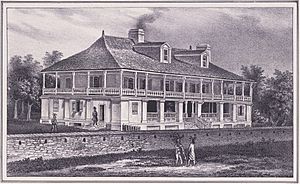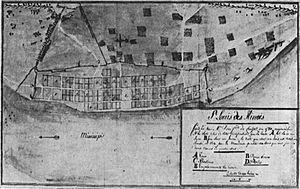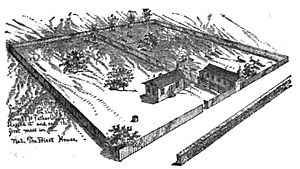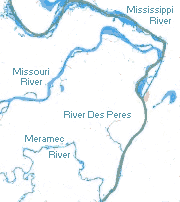History of St. Louis (1763–1803) facts for kids
The history of St. Louis, Missouri from 1763 to 1803 tells the story of how this important city began. It covers the time when the land changed from French to Spanish control, the founding of St. Louis itself, and its role in the American Revolution. Later, the area became part of the United States through the Louisiana Purchase. Since then, St. Louis has grown into a major city.
Contents
How St. Louis Began: Early Plans and Founding
In 1763, the French Governor, Jean-Jacques Blaise d'Abbadie, gave a special trading right to Gilbert Antoine de St. Maxent. He was a merchant from New Orleans. Maxent quickly hired Jean Francois Le Dee and Pierre Laclède to build trading posts. These posts would be in the Illinois Country, a good place for fur trading.
Just before Laclède left in August 1763, news arrived. France had given its land on the east side of the Mississippi River to Great Britain. This was part of the Treaty of Paris (1763). This made the trading posts on the west side of the river even more important. Laclède's group included his young stepson, Auguste Chouteau, and about twenty boatmen. They carried many trade goods.
On November 3, 1763, the group reached Ste. Genevieve and Fort de Chartres. They stored their goods there. They needed to build a new settlement further north quickly, as winter was coming. In December, Laclède and Chouteau looked for good spots on the west bank. Laclède found a perfect place. It had a gentle slope and a rocky cliff above the river's floodwaters. Laclède marked the spot. He told Chouteau to come back in the spring to clear the land. The men returned to Fort de Chartres for the winter. In February, Laclède sent Chouteau and 30 men to start building cabins and a storage shed. The settlement officially began on February 15, 1764.
Laclède arrived in April 1764 to check on the site. He named the village St. Louis. He also gave detailed plans for the streets and his main office building. The village plan was like New Orleans. It had a public market by the river and a grid street pattern. The market, Laclède's office, and a church were in a line west from the river.
Many smart people moved to St. Louis, like Marie-Thérèse Bourgeois Chouteau. She gave advice to new residents on how to succeed in the new town.
French Creole families from Cahokia and Fort de Chartres quickly moved to St. Louis in 1763 and 1764. They were worried about how British soldiers would treat them. Laclède, as the main leader, gave land lots to these new settlers. Soon, St. Louis became a popular place to move. About forty families came from settlements on the east bank.
In October 1765, the British took full control of the east bank. The French Lieutenant Governor, Louis St. Ange de Bellerive, officially moved the capital of upper Louisiana to St. Louis. After he arrived, St. Ange was in charge of giving out land. Land transfers were written down in special "land books." By 1770, St. Ange had given out eighty-one lots. This covered almost all of the village's forty-nine available blocks.
Life Under Spanish Rule: Changes and Daily Life
Spain secretly gained control of Louisiana in 1762. This was through the Treaty of Fontainebleau. But the first Spanish governor, Antonio de Ulloa, only arrived in New Orleans in March 1766. Ulloa did not rule for long. French colonists forced him out in the Louisiana Rebellion of 1768.
Alejandro O'Reilly replaced him as governor. He stopped the rebellion. In August 1769, he named Don Pedro Piernas as lieutenant governor of upper Louisiana. The French leader of St. Louis, St. Ange, officially gave control to Piernas on May 20, 1770. St. Ange then became Piernas' assistant and an adviser on Indian affairs. After the change, Piernas confirmed the land grants made by St. Ange and Laclède. He also rented Laclède's old office as government offices. Spanish soldiers helped keep the town safe.
Early landowners in St. Louis had to build wooden or stone fences around their lots for safety. Lots had sheds, barns, vegetable gardens, and sometimes fruit trees. There were no separate shops. Business was usually done in homes or in the market square. Houses varied from small huts to large buildings like Laclède's stone office. Most homes were square. They were built with wood posts in the ground and had steep oak roofs. This was a common Creole design.
Residents used common land south of town for firewood and pasture. This land was reduced in size over time. The remaining land became Lafayette Park in 1838. Each lot owner also got a long, narrow strip of field for farming. Four such fields were created between 1766 and 1769. By the 1790s, nearly 6,000 acres were farmed around St. Louis. Even with farming, fur trading was very important to many residents.
The villagers were mostly Roman Catholic. But they were not very religious at first. When Piernas arrived in St. Louis in 1769, there was no church. Laws about religious practices were not enforced. Within a month of taking office in May 1770, Piernas urged residents to build a log chapel. Father Pierre Gibault dedicated it on June 24, 1770. He held services regularly. In May 1772, a Capuchin priest named Valentine became the first resident priest. He baptized many people and held funerals and weddings. A new church was planned in 1774. In May 1776, Father Bernard de Limpach became the first pastor of the St. Louis parish. With the new church building, Catholic religious practice became a regular part of life in St. Louis.
One early problem for the Spanish leaders was Indian slavery. Spanish Governor O'Reilly had banned it. Piernas published this ban in May 1770. However, people in St. Louis ignored the ban. Piernas asked the new Spanish governor, Luis de Unzaga, for advice. They agreed to stop buying new Indian slaves. But people could keep the slaves they already had and any children born to them. Over time, many Indian slaves were replaced by African slaves. Some Indian slaves remained enslaved until the 1830s. At that time, freedom suits led to their freedom. In 1772, a count showed the village had 637 people. This included 444 white people and 193 African slaves. No Indian slaves were reported because they were technically illegal.
In 1775, Piernas was promoted and moved to New Orleans. Control of St. Louis went to Lieutenant Colonel Francisco Cruzat. He also had a relaxed way of enforcing Spanish rules. The village population grew to almost 700. In 1775, St. Louis merchants sent hundreds of quintals of flour to New Orleans. In 1778, Cruzat was removed as commander. This was ordered by Spanish Governor Bernardo Galvez. The British had complained that Cruzat allowed Spanish agents to enter British land in Illinois. In the same year, Pierre Laclède, the founder of St. Louis, died. He was returning from a trading trip to New Orleans. Galvez replaced Cruzat with Fernando de Leyba. Leyba moved the government offices from Laclède's old stone house. He sold the property to Auguste Chouteau.
St. Louis During the American Revolution
When the British and Americans started fighting, Spanish governors in New Orleans helped the American rebels. They sent weapons and ammunition. Fernando de Leyba, the new commander of St. Louis, was told to help American rebels. He was also told to encourage Catholics in British territory to move to St. Louis.
When Leyba arrived in St. Louis, he invited George Rogers Clark to a banquet. Clark was an American colonel. He was leading the Illinois campaign and had just captured Kaskaskia. Leyba also encouraged St. Louis merchants to give Clark's forces weapons. He promised that Clark would pay them back.
By early 1779, the British commander Henry Hamilton had taken back Vincennes. His forces were moving toward Kaskaskia. Hamilton told Leyba and Galvez that he would attack Spanish forces if Americans retreated to Spanish land. This meant St. Louis could be attacked. But Clark defeated the British forces and captured Hamilton in February 1779. This stopped the threat to St. Louis.
Spain joined the Americans in June 1779. The British then planned to attack St. Louis and other Spanish settlements along the Mississippi. They planned to use fur traders and Native Americans.
The British force left Prairie du Chien on May 2, 1780. They had over 200 traders and Native Americans. But an American trader had already warned Leyba in St. Louis about the plan. This gave St. Louis time to prepare defenses. Only one of four planned stone towers was built. It was near where Fourth and Walnut streets are today. The rest of the town was surrounded by over a mile of trenches. A British force of nearly 1,000 approached in early May. More Native American forces joined them. Over 150 militia members took their positions in the defenses around St. Louis.
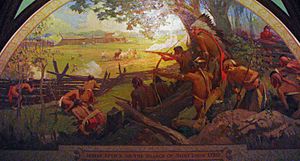
On May 26, the British and Native American forces attacked the town of St. Louis. But they were forced to retreat. The defenses and some Native American forces leaving helped St. Louis. Even though they lost, the British attack destroyed much of St. Louis' farmland and cattle. It killed 23 residents, wounded 7, and captured 25.
Leyba's reputation in St. Louis was hurt by the battle losses. He also could not pay merchants for supplies given to the Americans. Leyba died after a long illness on June 28, 1780. Galvez quickly brought back former commander Francisco Cruzat. Cruzat arrived in St. Louis with ammunition, weapons, and supplies to defend the town. In late 1780, Cruzat sent a group from St. Louis to attack British forces at Fort St. Joseph. This attack stopped any future British plans to attack St. Louis or other posts on the Mississippi.
After 1781, the British left the lands east of the Mississippi for good. These lands went to the Americans. But there was no strong American government there. So, many French Creole families moved to St. Louis from 1780 to 1783. This caused the population to grow by about 19% to 900 people, not including slaves.
Among these families were Gabriel Cerre and Charles Gratiot. They were merchants from Kaskaskia and Cahokia. When Cerre arrived in St. Louis, he was considered the richest merchant. He owned over 850 acres of land around St. Louis and 6,000 acres along the Meramec River. Cerre's daughters married into important Creole families. His oldest daughter, Marie Anne, married Pierre-Louis Panet in 1781. His second daughter, Marie Therese, married Auguste Chouteau, a co-founder of St. Louis, in 1786. His youngest daughter, Julia, married Antoine Soulard. He was a surveyor who added a lot of property to the edges of St. Louis.
Charles Gratiot was the second major merchant to move to St. Louis after the American Revolution. He also helped the community become richer. His English and trading skills helped the Americans during the war. In 1781, he moved to the west bank. There, he married Victoire Chouteau, Laclède's daughter and Auguste Chouteau's sister. In the 1790s, he traded with Americans moving west. He also ran a mill and a distillery on his farm west of the village.
Through land grants and purchases, Gratiot became one of the biggest landowners in the area. His main farm stretched far west from where Kingshighway Boulevard is today. It went from the northern edge of Forest Park to Chippewa Avenue on the south. Gratiot and his wife raised nine children. They became important and wealthy, especially his son Charles Gratiot, a famous engineer and soldier. The Gratiot and Cerre merchant families married into the Chouteau family. This created a society in the 1780s and 1790s that was led by French Creoles. They also had family ties to Spanish government officials, like Lieutenant Governors Piernas and Cruzat.
St. Louis Changes Hands: From Spain to France to the U.S.
Throughout the 1790s, the area around St. Louis grew. Small farmers sold their lands to the Cerres, Gratiots, Soulards, or Chouteaus in St. Louis. These farmers moved to newer towns founded after St. Louis. These included Carondelet, founded in 1767. It had 181 residents in 1796 and usually produced extra food.
Another village was St. Charles, founded about 20 miles northwest of St. Louis. Its population in 1800 was about 600. The third main village was Florissant, founded about 15 miles northwest of St. Louis. It had nearly 300 people. By 1800, only 43% of the St. Louis district's population lived within the village of St. Louis itself.
Some of these small farmers and craftspeople heard about the French Revolution. In the late 1790s, they started to demand that Louisiana return to a French government that believed in equality. On September 22, 1796, a group of St. Louis craftspeople held a "noisy celebration" for this idea. To show its power, the Spanish governor sent ships and soldiers with military supplies to strengthen Spanish control of St. Louis.
However, even as Spanish officials tried to keep control of Louisiana, the Spanish government was trying to give the territory back to France. Spain secretly returned the Louisiana territory to France in October 1800. This was part of the Treaty of San Ildefonso. French leader Napoleon Bonaparte promised not to sell Louisiana without offering it to Spain first. So, Spain officially gave control of Louisiana to France in October 1802. But Spanish leaders remained in charge of St. Louis during the time France owned it.
When control was transferred, the Spanish leader in New Orleans (following Napoleon's orders) took away the right for American merchants to store goods there. This made the United States and President Thomas Jefferson send negotiators to France in early 1803. Their goal was to get navigation rights on the Mississippi River. However, Napoleon instead sold all of Louisiana, including St. Louis, to the United States on April 30, 1803. This was part of the Louisiana Purchase.
The U.S. Senate approved the treaty in November 1803. The transfer of power from Spain became official in St. Louis at a ceremony called Three Flags Day. On March 8, 1804, the flag of Spain was lowered at the government buildings in St. Louis. According to local tradition, the flag of France was then raised. On March 10, 1804, the French flag was replaced by the flag of the United States.


